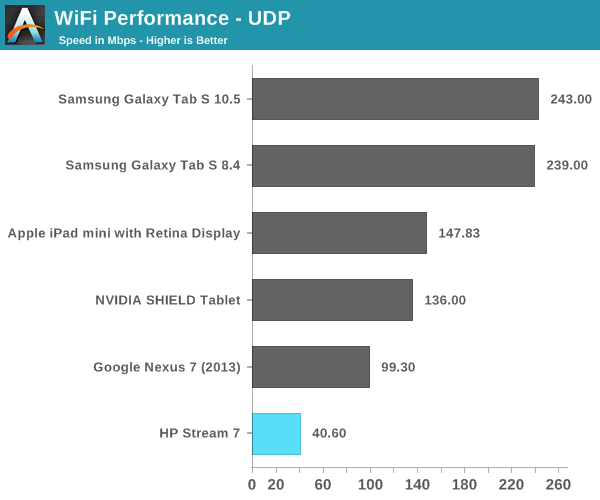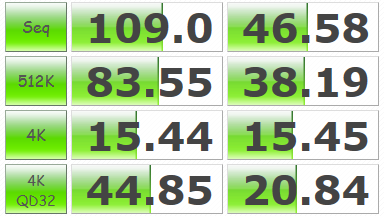HP Stream 7 Review: A $119 Windows Tablet
by Brandon Chester on December 19, 2014 8:00 AM ESTCamera
It looks like including a camera is now a requirement for pretty much any device, and so even the Stream 7 has a front-facing and a rear-facing camera. In the Windows device manager, the front camera identifies itself as "Camera Sensor GC310". I haven't been able to find any information about it, but the image quality leads me to believe that it may be best for people to not know where it came from. The rear camera idenitifes itself as HM2056, which I was able to find information about. It's made by a company called Himax Imaging, and if you haven't heard of them it's okay, because I hadn't either. It's a 2MP 1/5" sensor, which translates to 1.75 micron pixels. It has no auto focus, and that combined with the specifications leads me to believe that this is normally intended to be a front-facing sensor.
As you can see, the output is really bad. The text on the back of the books is illegible, most detail is lost, and there's noise everywhere. It's just honestly not a good camera, and it's something I would only use as a last resort. It's somewhat annoying that HP felt the need to even put a rear camera on the Stream 7, as it adds to the BOM and the money could have been better used on something like a larger battery.
NAND
I mentioned earlier that the Stream 7 doesn't even have enough storage to fit PCMark 8 and some of the other benchmarks we use. Out of the box, you get around 18.5GB free. This means that we can't run our typical Windows storage benchmarks, so I've used CrystalDiskMark to get an idea of how the storage performs.
I wouldn't try making direct comparisons between this and our storage benchmarks on Android and iOS, but it's still able to give you an idea of what you can expect. The Stream 7 uses Samsung's MGB4GC eMMC solution, so we can't expect the same storage performance that you get from Windows devices with a full blown SSD. The read and write performance ends up being pretty good for an eMMC solution, although I'm suspicious of the 4k random write result considering how even the best eMMC solutions we've seen in Android and iOS tablets top out around 3MB/s.
WiFi
The HP Stream 7 uses a Realtek RTL8723BS solution for WiFi and Bluetooth. This is a single spatial stream 802.11n part, with no 5GHz support and only 20MHz channel width. That means that we're dealing with a theoretical maximum speed of 72Mbps. In real world use, it's quite a bit less, as you can see below.

Again, at $119 this is expected and can be excused. Faster WiFi would be nicer, but it's not free. My only complaint about this speed in the real world is that the slow WiFi makes it difficult to move large files over the network onto the Stream 7. This wouldn't be an issue if these Windows tablets allowed you to directly move files to them from another computer over USB, but they don't. I've also encountered issues with the WiFi disconnecting intermittently, which is incredibly frustrating when it means you have to begin transferring a large video from the beginning. I've contacted HP about this to see if they're aware of this issue, as I've seen complaints about it from other users, but I haven't received a response.
Misc
I am unfortunately not equipped to do objective audio testing on the Stream 7. It uses Realtek's audio codec, and so it isn't likely to be anything exceptional. The bottom mono speaker is adequate; there's not much to be said about it. Unfortunately, everything comes crashing down when you try to use the 3.5mm jack. Even if the Stream 7 had the best audio solution in the world, it would be crippled by this defect that I cannot believe made it to production.
Essentially, the 3.5mm jack has a great deal of noise and static, and it makes it effectively unusable. I have confirmed this with two other owners, and there are complaints about it on the web. It's likely that there's an insufficient amount of shielding for the audio port and PCB connections, and it's extremely disappointing. With its support for all the great video players on Windows, the Stream 7 could have been an inexpensive and powerful video player. But unless you're going to use the built-in speaker or Bluetooth headphones/speakers, there's no way to listen to audio on this tablet. When I reached out to HP about the WiFi connection issues I also asked about this, but again I haven't received a response.


















157 Comments
View All Comments
ddriver - Friday, December 19, 2014 - link
With a single gig of ram it is far from very exciting or usable... I've been looking for a small factor x86 tablet with 4 gigs of ram, but all devices are crippled to 2 gigs of ram max.schizoide - Friday, December 19, 2014 - link
Have you tried one? It works OK with 1GB RAM. You can browse the web, including heavy sites, just fine. It runs Office quite adeptly. All the standard desktop stuff works great, as does (obviously) metro apps.Obviously it would be much better with 2GB. No doubt. But it _is_ usable with 1.
ddriver - Friday, December 19, 2014 - link
I can do that on my android phone, the benefits of having x86 device is running full desktop applications which are not available for android, which do not run at all well with a single gigabyte eof ram.That's why i'd prefer a device that has not been crippled to only serve for basic tasks by having little ram, which is not expensive at all.
JarredWalton - Friday, December 19, 2014 - link
Of course, running a desktop application on a tablet is almost as bad as trying to use Teamviewer to control a Windows device from an Android tablet. Windows desktop applications, especially legacy apps that were not built with any thought for a touch interface, are just not a great experience.ddriver - Friday, December 19, 2014 - link
I don't care about the user experience, my primary intent is to run a full C++ compiler on the device. It is the kind of things you just run without interacting with it at all.Tikcus9666 - Friday, December 19, 2014 - link
I've been using a Toshiba encore 8 for about 10 months now, after using previous android tablets. App selection does not bother me.Web browser works
Email works
youtube works
twitter works
Amazon instant video works (granted need to use desktop version of IE) this is one app i would like
Netflix works
I got a full version of office 2013 so, I can edit documents when out on the road (although would never want to spend hours working on a 8" screen)
Bottom line it does everything I need at a fraction of the cost of other tablets and it comes with office.
One thing the reviewer should note, on a desktop/laptop without a touch screen Windows 8.1 automatically boots to desktop so you barely see the start screen, you don't need any 3rd party apps to do that (also right clicking on the start button, gives you lots of options that used to be in the start menu)
ados_cz - Monday, December 22, 2014 - link
Well, the included Office 365 is built with touch in mind, I have already created few tables for my work using touch screen and finished the last 20% of work on my desktop. Btw, I prefer the desktop IE on my Linx 7 as well. To me it is very usable even for desktop apps.hughlle - Friday, December 19, 2014 - link
Then this device is clearly not for you. you're complaining that an super budget device doesn't have high end specs.Out of interest, what's the cheapest x86 tablet with 4gb of ram you've found?
Why do people read reviews of products and take the time to moan about the fact that it's not what they need. Shop nfor something else.
Azurael - Friday, December 19, 2014 - link
I got a refurbished i3 Dell Venue 11 for £215. It has 4GB of RAM and a real 128GB SSD. It's bigger than this, I'll grant you, but it's a lot of power for the money and on a larger screen - desktop apps are usable. The latest version of Photoshop CC with a stylus is amazing!These devices got generally favourable reviews but suffered from terrible bugs (it froze every 10 minutes or so out of the box!) until a series of firmware updates for almost every component of the device (a touch screen firmware I get, but firmware for the LCD itself to fix a panel self refresh issue?! I didn't even know that was possible...) and now it's great with amazing battery life too.
Sadly, Linux currently has a bug which prevents the internal LCD from working with graphics acceleration, although I have got OS X booted on it. I'm missing a few Android apps right now, so hopefully the kernel bug will get fixed because I haven't found Bluestacks a very good experience. It has 64-bit UEFI and a CSM so in theory it should run anything...
It's a bit odd going from a Nexus 7 with a 1920x1200 7" panel to this with a 10.8" 1920x1080 one. I guess high DPI windows tablets will eventual arrive but at least this panel has good contrast and seems relatively well calibrated.
I can even play a bit of Portal 2 on it!
schizoide - Friday, December 19, 2014 - link
You're wrong. They run just fine.That was the point of my post.